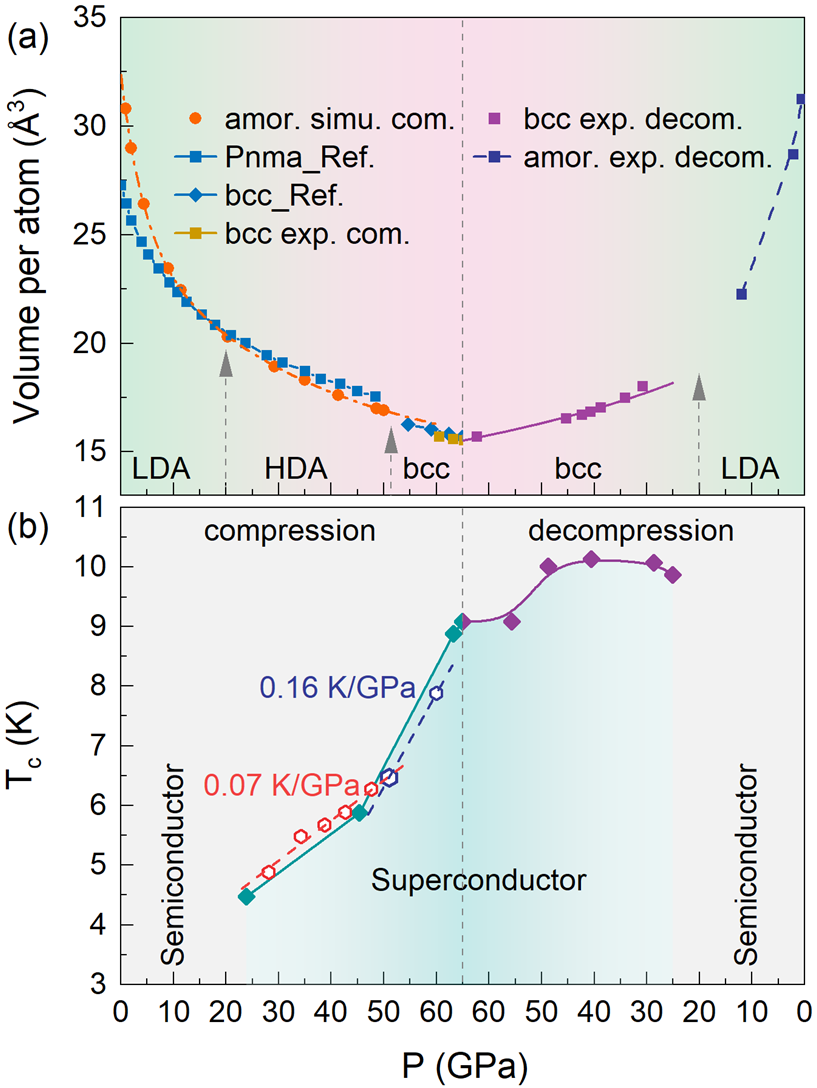Density-change-driven superconductivity in amorphous solids - Drs. Kai Zhang, Nana Li and Wenge Yang
SEPTEMBER 16, 2021
The correlation between superconductivity and a disordered structure is an interesting and challenging topic in condensed matter physics. Although scientists discovered amorphous superconductors as early as 1954, their superconducting mechanism has remained mysterious due to their complex chemical and structural disorder, and limited investigative experimental techniques under extreme conditions. Recently, a new work from a research team led by Dr. Wenge Yang of HPSTAR (Center for High Pressure Science &Technology Advanced Research) in collaboration with Prof. Ming Xu of Huazhong University of Science and Technology, and Prof. Matthias Wuttig of RWTH Aachen University uncovered a close relationship between superconductivity and density in amorphous solids. Detailed results are published in the recent issue of Physical Review Letters.
Under ambient conditions, the atoms in amorphous materials have a disordered arrangement where the electrons are severely localized, resulting in high electrical resistance in amorphous solids. However, many weakly disordered systems, including metallic glasses and high-entropy alloys, can also exhibit superconductivity. Disordering can even enhance the superconductivity of some amorphous systems. However, when the electronic localization caused by disorder reaches a critical level, the opposite effect superconductivity-insulation-transition will occur. From a structural perspective, it is difficult to accurately quantify the disorder in amorphous solids because they cannot be characterized as effectively as crystals, making the origin of their superconductivity uncertain.
"High pressure is a clean and efficient tool for tuning the physical properties of materials. So we used high pressure to modulate the atomic ordering of an amorphous solid to explore the evolution in the electrical localization further," said Dr. Kai Zhang, the first author of the study.
A systematic high-pressure experimental and simulation studies on amorphous Sb2Se3 were conducted to explore the pressure effect on its atomic arrangement and electron localization. Amorphous Sb2Se3 was chosen for its relatively stable disordered structure. Furthermore, its crystalline state exhibits a wealth of electronic behaviors such as strong spin-orbit coupling, topological insulation, and pressure-induced superconductivity.
By compressing to 240,000 times the atmospheric pressure, the amorphous semiconductor Sb2Se3 exhibited the same superconductivity as the crystallized Sb2Se3. Moreover, in situ high-pressure high-energy X-ray diffraction shows that amorphous Sb2Se3 has a density crossover from a low-density to high-density state while the sample becomes superconducting.

With further compression, high-density amorphous Sb2Se3 crystallized at about 500,000 times the atmospheric pressure, with a noticeable enhancement in superconductivity transition temperature. Interestingly, superconductivity has a close correlation with the density change during the decompression process.
Additional theoretical calculations show that the intermediate-state to high-density phase is the key to superconductivity occurrence in amorphous Sb2Se3. The high-density amorphous phase gave birth to ordered local structural units for the initial superconducting behavior.
“Actually, the high-density state is dominated by a unique “metavalent’ chemical bond, which lies in between the low-pressure covalent bond and the high-pressure metal bond, unlike the low-voltage amorphous semiconductor phase and the high-pressure crystalline metal phase,” explained Dr. Wenge Yang. "Interestingly, the metavalent bond has been successfully applied in fields such as phase change materials or thermoelectric materials”.
“Our study provides a deep understanding of amorphous superconductors’ atomic structure and electronic behavior, and amorphous phase change materials more generally. Exploring new materials such as thermoelectric materials stimulates broader research interest,” added Dr. Kai Zhang.
Caption: Density dependence of superconductivity in amorphous Sb2Se3 at high pressure.
超导电性与无序结构的相关性一直是凝聚态物理领域一个有趣的和具有挑战性的难题。虽然早在1954年科学家们就发现了非晶超导体,但由于非晶超导体中复杂的拓扑和化学无序性,以及极端条件下实验技术的局限性使得非晶体中的超导机制一直是一个未解之谜。近日,北京高压科学研究中心的杨文革研究员与华中科技大学的徐明教授,以及德国亚琛工业大学的Matthias Wuttig教授合作的研究团队发现非晶态的密度和超导性具有紧密的联系。相关结果以“Superconducting phase induced by a local structure transition in amorphous Sb2Se3 under high pressure”为题发表于近期的《物理评论快报》上。
